All right, let’s come clean and admit this isn’t really a review of Ducati’s segment-busting new bike, the power-cruiser-esque Diavel. But from info recently gathered – including comments from Ducati’s CEO, plus the timeless seat-bounce test – we now have a clearer idea of the qualities of this controversial new Italian steed.
Factory MotoGP rider Nicky Hayden Hayden rode the Diavel onto the LA Auto Show’s stage two days ago, culminating with a tire-smoking burnout. Ducati was there to share the spotlight with the AMG division of Mercedes-Benz, together announcing a new partnership that sees the high-performance AMG sub-brand sponsoring Ducati’s MotoGP team.
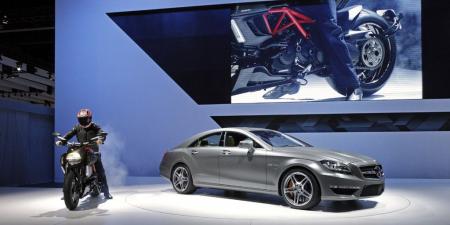 Ducati’s MotoGP rider Nicky Hayden smokes the Diavel’s tire next to an AMG CLS 63. AMG announced sponsorship of Ducati’s GP team at the LA Auto Show. Ducati’s MotoGP rider Nicky Hayden smokes the Diavel’s tire next to an AMG CLS 63. AMG announced sponsorship of Ducati’s GP team at the LA Auto Show. |
After Hayden’s smoky entrance, the hundreds of international automotive media promptly ignored the new 550-hp CLS 63 AMG and flocked over to the chunky Diavel.
The deal includes sponsorship of Ducati’s GP team for two years plus an option to extend it, and the marketing effort will also encompass test rides/drives at each other’s events. And company reps hinted about the possibility of one day cooperating on future products.
“I’m pretty sure our AMG Performance Studio will be able to capture the spirit of Ducati in a very special AMG someday,” teased Ola Källenius, CEO of Mercedes-AMG GmbH, “but that’s something for another show.”
“Our engineers and our designers will have a lot of input from them, and vice versa their designers,” Gabriele del Torchio, president and CEO of Ducati Motor Holding S.p.A, told Motorcycle.com.
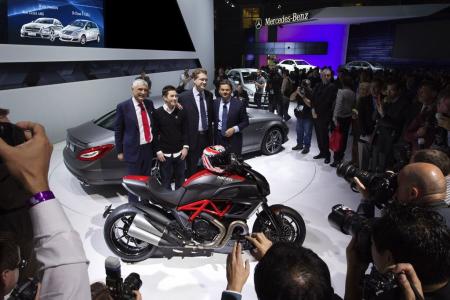 A throng of auto journalists gather around the new Ducati Diavel. Ducati CEO Gabriele del Torchio stands next to his GP rider Nicky Hayden, while AMG and Mercedes brass enjoy the shared spotlight. A throng of auto journalists gather around the new Ducati Diavel. Ducati CEO Gabriele del Torchio stands next to his GP rider Nicky Hayden, while AMG and Mercedes brass enjoy the shared spotlight. |
Coincidentally, the companies share a history of using desmodromic valve actuation. Mercedes employed the mechanical-closing valvetrain design in its fearsome W196 Grand Prix racer from 1954, while Ducati’s legendary engineer Fabio Taglioni first used the system in the 1956 125 Desmo GP bike, and the Bologna-based company continues to use desmo valves in its current range of V-Twin engines.
The 1199cc V-Twin from the odd but successful Multistrada finds a new home in the Diavel, seen for the first time in North America at this week’s auto show. We were able to try it on for size shortly after Hayden warmed it up.
“I’ve got a Ducati 848 at home, but I might need to add one of these because it’s something different,” said the Kentucky Kid.
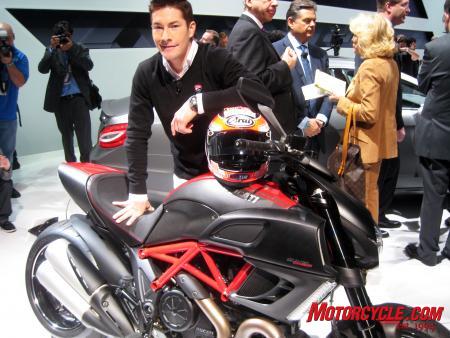 Nicky Hayden, the 2006 MotoGP world champion, leans on the Diavel shortly after making a grand entrance at the LA Auto Show. He may be smiling because he likes the bike, or it might be because he was just told he’ll be getting an AMG Mercedes as part of a new sponsorship agreement. Nicky Hayden, the 2006 MotoGP world champion, leans on the Diavel shortly after making a grand entrance at the LA Auto Show. He may be smiling because he likes the bike, or it might be because he was just told he’ll be getting an AMG Mercedes as part of a new sponsorship agreement. |
The Diavel is indeed different, and it’s often been derided by traditional Ducatisti who revere the brand’s performance heritage. However, the Diavel (“devil” in Bolognese) is directed at a new clientele.
“I truly believe that we’re going to open a new market segment, as we did many years ago when we introduced the Monster,” del Torchio commented. “It was a new category in the market, and we think the Diavel will do the same.”
Ducati reps are cautious about describing their new creation as a cruiser, even if its long and low stance points it in that direction relative to something like an 1198.
“It’s very comfortable, very powerful and easy to ride,” related del Torchio, who has ridden the Diavel in prototype form.
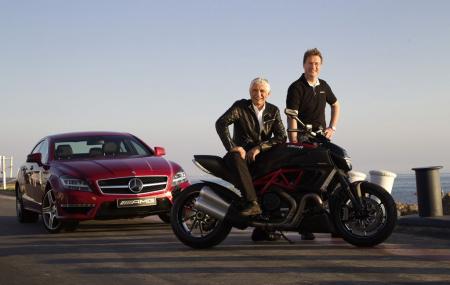 Ducati’s CEO Gabriele del Torchio astride his company’s bold new model while Mercedes-AMG CEO Ola Källenius wishes his CLS 63 looks as cool as the Ducati. Ducati’s CEO Gabriele del Torchio astride his company’s bold new model while Mercedes-AMG CEO Ola Källenius wishes his CLS 63 looks as cool as the Ducati. |
Getting a chance to see the Diavel in the flesh, it looks smaller than the impression it gives in photos. It takes but a short swing of a leg to get onto the 29.5-inch seat, made possible by a low-mounted horizontal rear shock. The saddle’s bucket-like perch feels comfy but doesn’t allow much fore/aft room, and it’s nicely highlighted by red stitching.
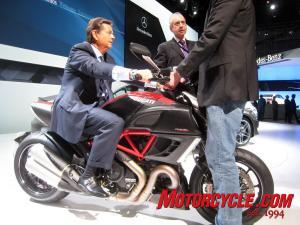 Ernst Lieb, CEO of M-B USA, aboard the Diavel. Note the rider ergonomics that are comfortable yet sporty.
Ernst Lieb, CEO of M-B USA, aboard the Diavel. Note the rider ergonomics that are comfortable yet sporty. Pulling the Diavel off its sidestand requires little effort, as the “Carbon” version we sat on (with forged-aluminum wheels and carbon-fiber accents) is said to weigh just 456 pounds – less than any 750cc-plus cruiser we can think of. And this is a 1200cc “cruiser” with a 162 galloping horses, enough, said del Torchio, to reach nearly 150 mph.
Further putting the cruiser label to rest is the Diavel’s cornering clearance. Del Torchio says it has up to 41 degrees of lean angle. To put that in perspective, consider that Harley’s raciest bike, the XR1200X, can achieve a 39- or 40-degree lean before touching hard parts.
Pirelli played a key part in the Diavel’s development, creating a wide (240mm) rear tire with a more rounded profile than fat cruiser rubber. Pirelli reps claim that it offers neutral turn-in response unlike anything this wide that was previously offered. If that broad bun fails to get your attention, the imposing stacked mufflers (that look big enough to fire mortar rounds) will.
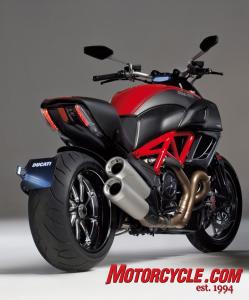 The Diavel’s rear view is perhaps its most striking. The massive exhaust pipes and tire make for an imposing impression.
The Diavel’s rear view is perhaps its most striking. The massive exhaust pipes and tire make for an imposing impression.Pillion accommodations are cleverly unobtrusive – footpegs fold down from the tailsection on thin brackets, while a grab handle slides out from its stowed area above the taillight.
So, although we don’t really yet know how the Diavel will ride, we have some positive first impressions. It has a captivating presence in person, and despite its cruiser leanings, it looks every inch like a Ducati with its red trellis frame and sport-spec suspension and brakes. There is literally nothing quite like it.
And consider the Porsche Cayenne SUV, which was roundly scoffed at by sports-car purists. It went on to become the brand’s best seller, providing an outlet for those who desired a 911 but couldn’t reconcile buying one because of family or comfort concerns.
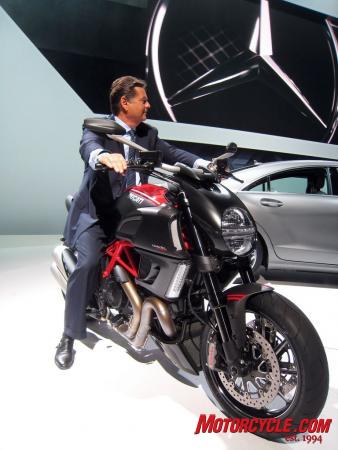 The Diavel’s front end shows its sportbike heritage, with Brembo radial-mount brakes, DLC anti-stiction fork tubes and gargantuan exhaust headers. The high-end Carbon version seen here features forged-aluminum wheels with machined accents. The Diavel’s front end shows its sportbike heritage, with Brembo radial-mount brakes, DLC anti-stiction fork tubes and gargantuan exhaust headers. The high-end Carbon version seen here features forged-aluminum wheels with machined accents. |
We can imagine a segment of two-wheel performance enthusiasts who have long admired Ducati’s racing legacy and Italian style but have been intimidated by the company’s hardcore sportbike lineup. The Diavel might be seen as an easier introduction to Ducati membership.
The Diavel’s performance bona fides will be put to the test early in February of 2011 during its press introduction. Stay tuned for the real review!
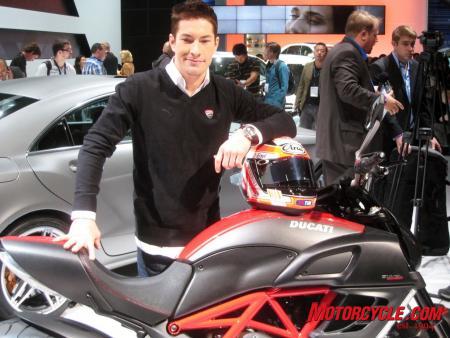 Although you won’t see Nicky Hayden piloting the Diavel around Grand Prix circuits, Ducati promises its niche-exploding bike will outrun anything in the cruiser class. Although you won’t see Nicky Hayden piloting the Diavel around Grand Prix circuits, Ducati promises its niche-exploding bike will outrun anything in the cruiser class. |
